The Cambridge History of China. Vol. 12: Republican China, 1912-1949, Part 1
Подождите немного. Документ загружается.

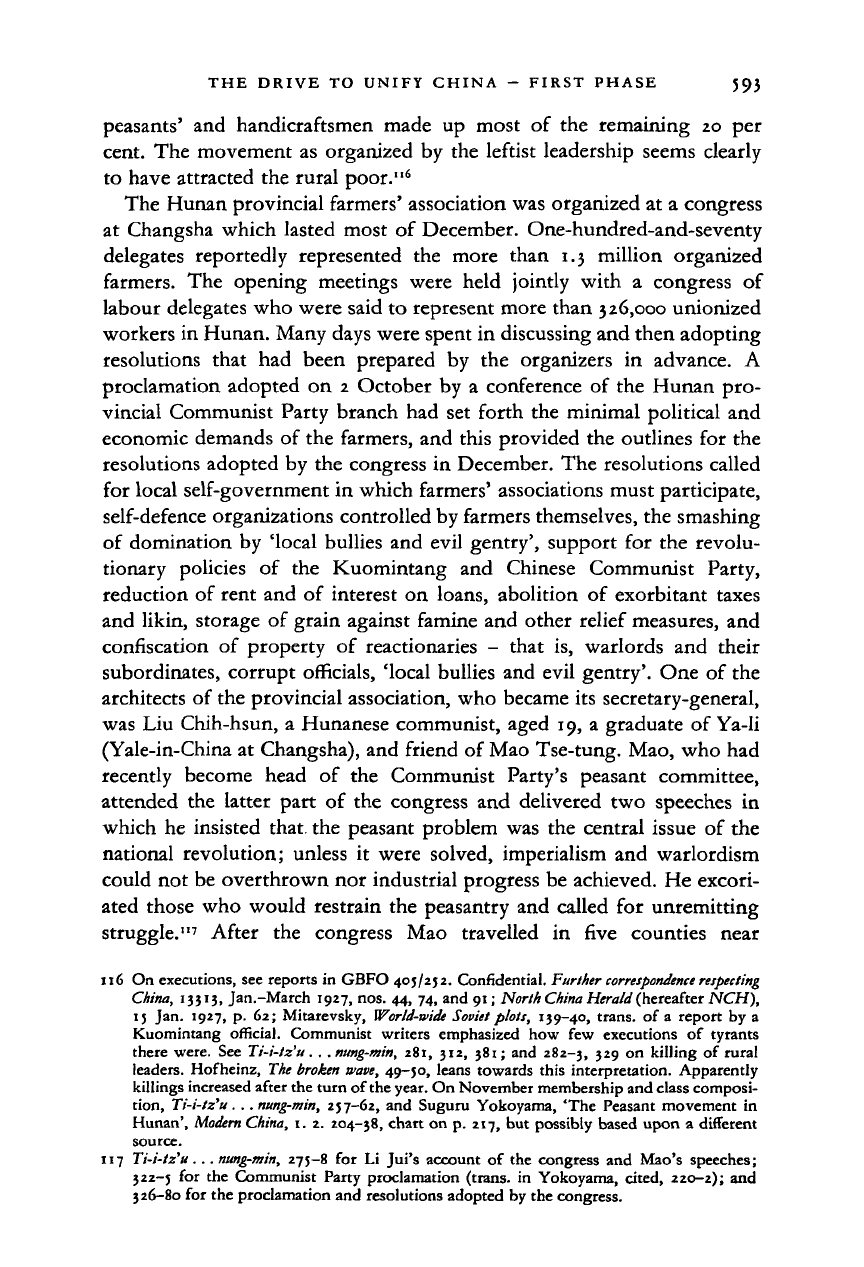
THE DRIVE TO UNIFY CHINA - FIRST PHASE 593
peasants' and handicraftsmen made up most of the remaining 20 per
cent. The movement as organized by the leftist leadership seems clearly
to have attracted the rural poor."
6
The Hunan provincial farmers' association was organized at a congress
at Changsha which lasted most of December. One-hundred-and-seventy
delegates reportedly represented the more than 1.3 million organized
farmers. The opening meetings were held jointly with a congress of
labour delegates who were said to represent more than 326,000 unionized
workers in Hunan. Many days were spent in discussing and then adopting
resolutions that had been prepared by the organizers in advance. A
proclamation adopted on 2 October by a conference of the Hunan pro-
vincial Communist Party branch had set forth the minimal political and
economic demands of the farmers, and this provided the outlines for the
resolutions adopted by the congress in December. The resolutions called
for local self-government in which farmers' associations must participate,
self-defence organizations controlled by farmers themselves, the smashing
of domination by 'local bullies and evil gentry', support for the revolu-
tionary policies of the Kuomintang and Chinese Communist Party,
reduction of rent and of interest on loans, abolition of exorbitant taxes
and likin, storage of grain against famine and other relief measures, and
confiscation of property of reactionaries - that is, warlords and their
subordinates, corrupt officials, 'local bullies and evil gentry'. One of the
architects of the provincial association, who became its secretary-general,
was Liu Chih-hsun, a Hunanese communist, aged 19, a graduate of Ya-li
(Yale-in-China at Changsha), and friend of Mao Tse-tung. Mao, who had
recently become head of the Communist Party's peasant committee,
attended the latter part of the congress and delivered two speeches in
which he insisted that, the peasant problem was the central issue of the
national revolution; unless it were solved, imperialism and warlordism
could not be overthrown nor industrial progress be achieved. He excori-
ated those who would restrain the peasantry and called for unremitting
struggle."
7
After the congress Mao travelled in five counties near
116 On executions, see reports in GBFO 405/252. Confidential.
Further correspondence respecting
China, 13313, Jan.-March 1927, nos. 44, 74, and 91; North
China
Herald (hereafter NCH),
15 Jan. 1927, p. 62; Mitarevsky,
World-wide Soviet
plots, 139-40, trans, of a report by a
Kuomintang official. Communist writers emphasized how few executions of tyrants
there were. See Ti-i-tz'u. . .
nung-min,
281, 312, 381; and 282-3, 3
2
9
on
killing of rural
leaders. Hofheinz, The
broken
wave,
49-50, leans towards this interpretation. Apparently
killings increased after the turn of the year. On November membership and class composi-
tion,
Ti-i-tz'u. .
.nung-min,
257-62, and Suguru Yokoyama, 'The Peasant movement in
Hunan',
Modern
China,
1. 2. 204-38, chart on p. 217, but possibly based upon a different
source.
117 Ti-i-tz'u. .
.nung-min,
275-8 for Li Jui's account of the congress and Mao's speeches;
322-5 for the Communist Party proclamation (trans, in Yokoyama, cited, 220-2); and
326-80 for the proclamation and resolutions adopted by the congress.
Cambridge Histories Online © Cambridge University Press, 2008
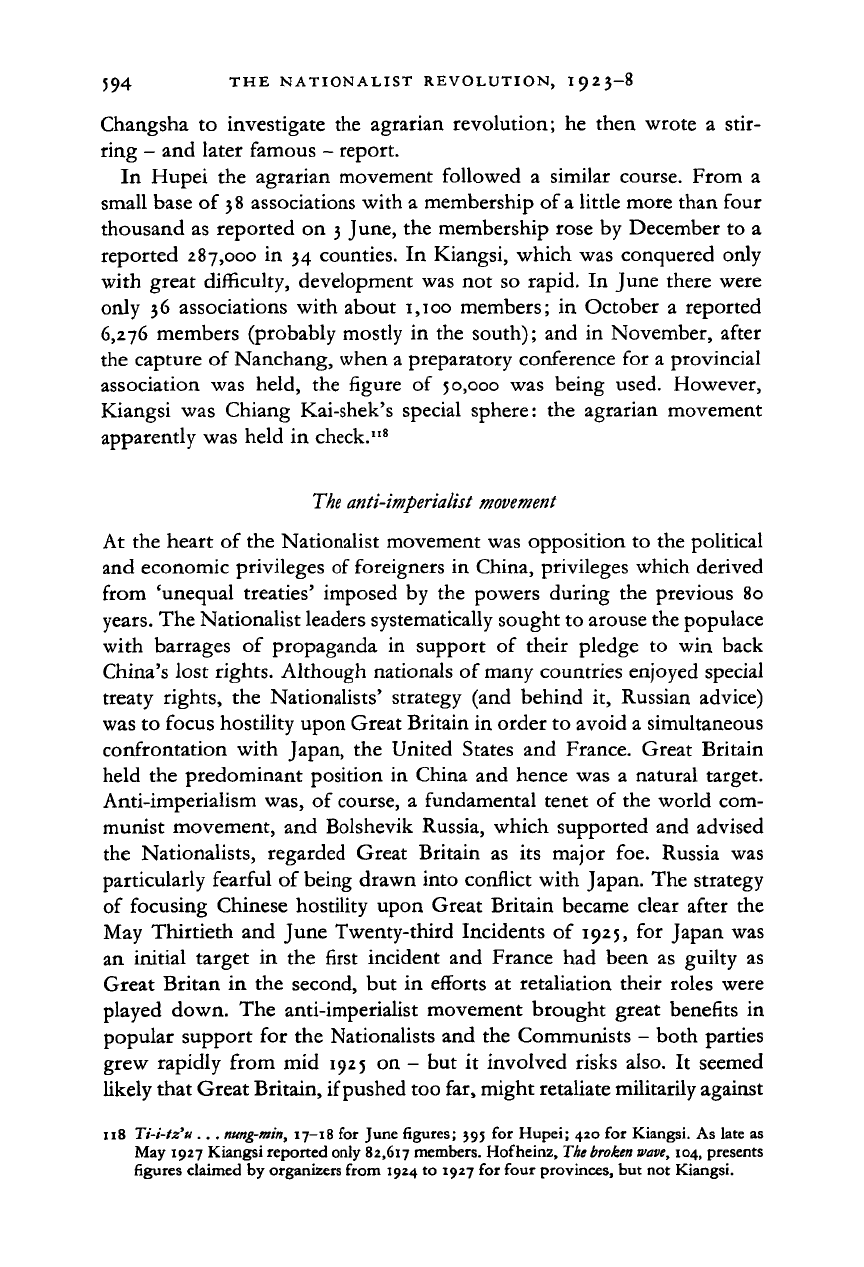
594 THE NATIONALIST REVOLUTION, I 9 2 3-8
Changsha to investigate the agrarian revolution; he then wrote a stir-
ring - and later famous - report.
In Hupei the agrarian movement followed a similar course. From a
small base of 38 associations with a membership of
a
little more than four
thousand as reported on
3
June, the membership rose by December to a
reported 287,000 in 34 counties. In Kiangsi, which was conquered only
with great difficulty, development was not so rapid. In June there were
only 36 associations with about 1,100 members; in October a reported
6,276 members (probably mostly in the south); and in November, after
the capture of Nanchang, when a preparatory conference for a provincial
association was held, the figure of 50,000 was being used. However,
Kiangsi was Chiang Kai-shek's special sphere: the agrarian movement
apparently was held in check."
8
The anti-imperialist movement
At the heart of the Nationalist movement was opposition to the political
and economic privileges of foreigners in China, privileges which derived
from 'unequal treaties' imposed by the powers during the previous 80
years.
The Nationalist leaders systematically sought to arouse the populace
with barrages of propaganda in support of their pledge to win back
China's lost rights. Although nationals of many countries enjoyed special
treaty rights, the Nationalists' strategy (and behind it, Russian advice)
was to focus hostility upon Great Britain in order to avoid a simultaneous
confrontation with Japan, the United States and France. Great Britain
held the predominant position in China and hence was a natural target.
Anti-imperialism was, of course, a fundamental tenet of the world com-
munist movement, and Bolshevik Russia, which supported and advised
the Nationalists, regarded Great Britain as its major foe. Russia was
particularly fearful of being drawn into conflict with Japan. The strategy
of focusing Chinese hostility upon Great Britain became clear after the
May Thirtieth and June Twenty-third Incidents of 1925, for Japan was
an initial target in the first incident and France had been as guilty as
Great Britan in the second, but in efforts at retaliation their roles were
played down. The anti-imperialist movement brought great benefits in
popular support for the Nationalists and the Communists - both parties
grew rapidly from mid 1925 on - but it involved risks also. It seemed
likely that Great Britain, if pushed too far, might retaliate militarily against
118 Ti-i-tz'u . . .
nung-min,
17-18 for June figures; 395 for Hupei; 420 for Kiangsi. As late as
May 1927 Kiangsi reported only 82,617 members. Hof heinz,
The broken
wave,
104, presents
figures claimed by organizers from 1924 to 1927 for four provinces, but not Kiangsi.
Cambridge Histories Online © Cambridge University Press, 2008
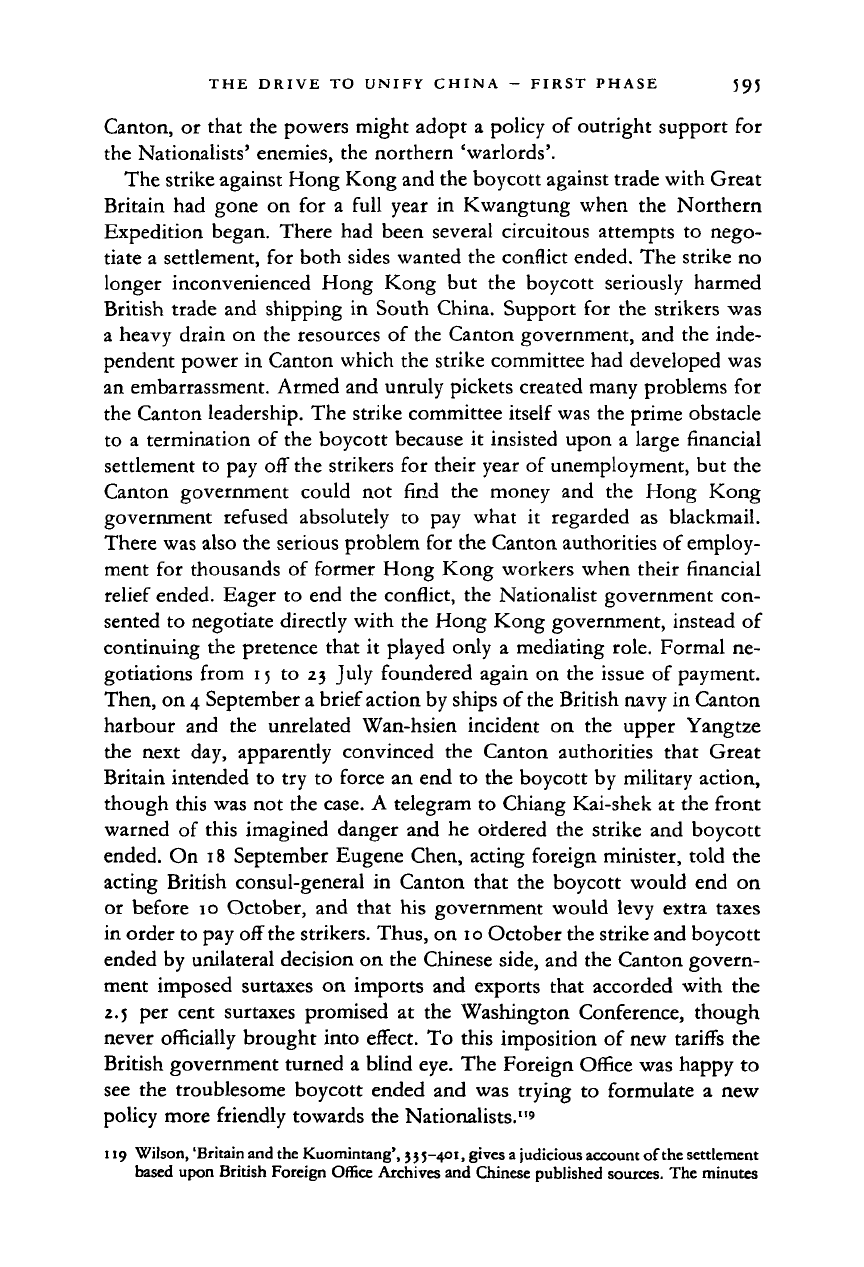
THE DRIVE TO UNIFY CHINA - FIRST PHASE 595
Canton, or that the powers might adopt a policy of outright support for
the Nationalists' enemies, the northern 'warlords'.
The strike against Hong Kong and the boycott against trade with Great
Britain had gone on for a full year in Kwangtung when the Northern
Expedition began. There had been several circuitous attempts to nego-
tiate a settlement, for both sides wanted the conflict ended. The strike no
longer inconvenienced Hong Kong but the boycott seriously harmed
British trade and shipping in South China. Support for the strikers was
a heavy drain on the resources of the Canton government, and the inde-
pendent power in Canton which the strike committee had developed was
an embarrassment. Armed and unruly pickets created many problems for
the Canton leadership. The strike committee itself was the prime obstacle
to a termination of the boycott because it insisted upon a large financial
settlement to pay off the strikers for their year of unemployment, but the
Canton government could not find the money and the Hong Kong
government refused absolutely to pay what it regarded as blackmail.
There was also the serious problem for the Canton authorities of employ-
ment for thousands of former Hong Kong workers when their financial
relief ended. Eager to end the conflict, the Nationalist government con-
sented to negotiate directly with the Hong Kong government, instead of
continuing the pretence that it played only a mediating role. Formal ne-
gotiations from 15 to 23 July foundered again on the issue of payment.
Then, on
4
September a brief action by ships of the British navy in Canton
harbour and the unrelated Wan-hsien incident on the upper Yangtze
the next day, apparently convinced the Canton authorities that Great
Britain intended to try to force an end to the boycott by military action,
though this was not the case. A telegram to Chiang Kai-shek at the front
warned of this imagined danger and he ordered the strike and boycott
ended. On 18 September Eugene Chen, acting foreign minister, told the
acting British consul-general in Canton that the boycott would end on
or before 10 October, and that his government would levy extra taxes
in order to pay off
the
strikers. Thus, on 10 October the strike and boycott
ended by unilateral decision on the Chinese side, and the Canton govern-
ment imposed surtaxes on imports and exports that accorded with the
2.5 per cent surtaxes promised at the Washington Conference, though
never officially brought into effect. To this imposition of new tariffs the
British government turned a blind eye. The Foreign Office was happy to
see the troublesome boycott ended and was trying to formulate a new
policy more friendly towards the Nationalists."'
119 Wilson, 'Britain and the Kuomintang', 335-401, gives a judicious account of the settlement
based upon British Foreign Office Archives and Chinese published sources. The minutes
Cambridge Histories Online © Cambridge University Press, 2008
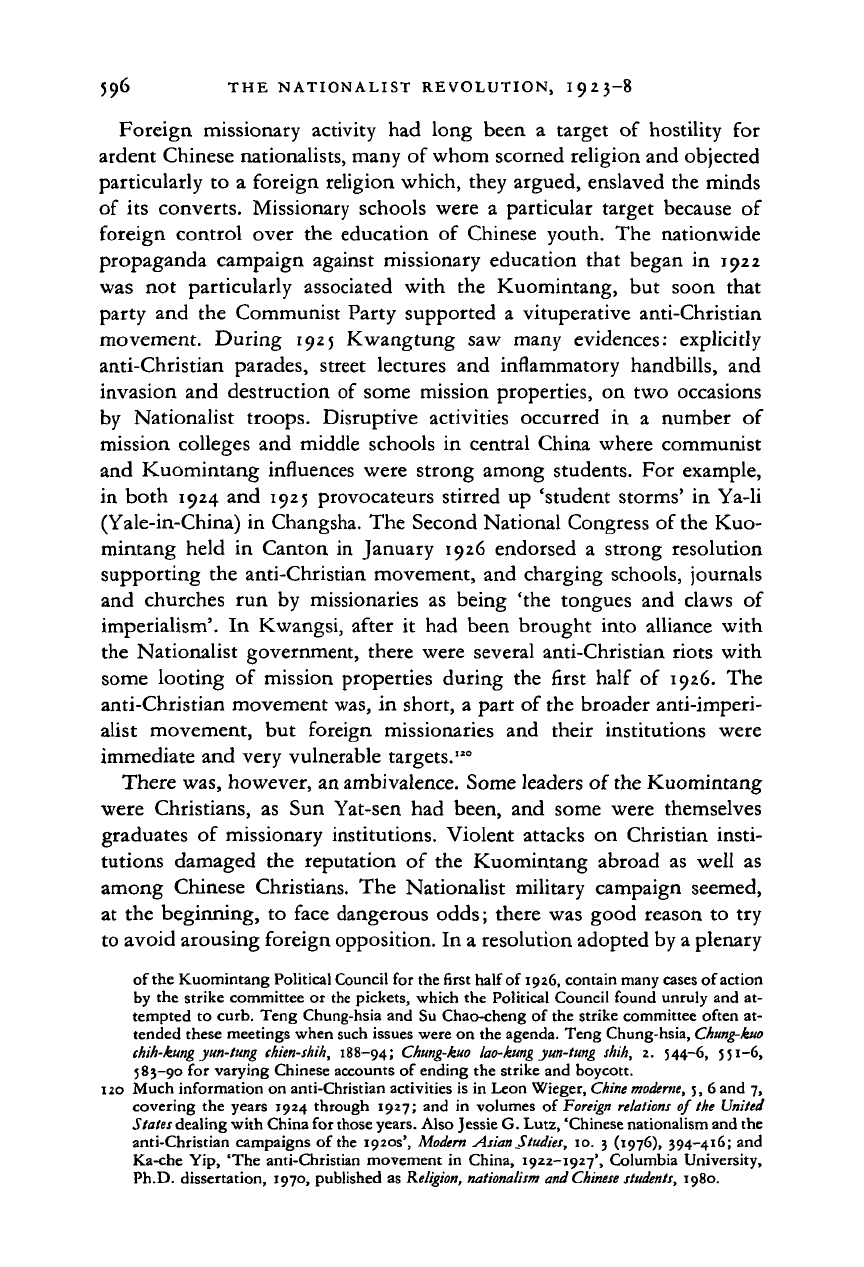
596 THE NATIONALIST REVOLUTION, I 9
2
3-8
Foreign missionary activity
had
long been
a
target
of
hostility
for
ardent Chinese nationalists, many
of
whom scorned religion and objected
particularly
to a
foreign religion which, they argued, enslaved
the
minds
of
its
converts. Missionary schools were
a
particular target because
of
foreign control over
the
education
of
Chinese youth.
The
nationwide
propaganda campaign against missionary education that began
in 1922
was
not
particularly associated with
the
Kuomintang,
but
soon that
party
and the
Communist Party supported
a
vituperative anti-Christian
movement. During
1925
Kwangtung
saw
many evidences: explicitly
anti-Christian parades, street lectures
and
inflammatory handbills,
and
invasion
and
destruction
of
some mission properties,
on two
occasions
by Nationalist troops. Disruptive activities occurred
in a
number
of
mission colleges
and
middle schools
in
central China where communist
and Kuomintang influences were strong among students.
For
example,
in both 1924
and 1925
provocateurs stirred
up
'student storms'
in
Ya-li
(Yale-in-China)
in
Changsha.
The
Second National Congress
of
the Kuo-
mintang held
in
Canton
in
January
1926
endorsed
a
strong resolution
supporting
the
anti-Christian movement,
and
charging schools, journals
and churches
run by
missionaries
as
being
'the
tongues
and
claws
of
imperialism'.
In
Kwangsi, after
it had
been brought into alliance with
the Nationalist government, there were several anti-Christian riots with
some looting
of
mission properties during
the
first half
of
1926.
The
anti-Christian movement was,
in
short,
a
part
of
the broader anti-imperi-
alist movement,
but
foreign missionaries
and
their institutions were
immediate
and
very vulnerable targets.
120
There was, however, an ambivalence. Some leaders
of
the Kuomintang
were Christians,
as Sun
Yat-sen
had
been,
and
some were themselves
graduates
of
missionary institutions. Violent attacks
on
Christian insti-
tutions damaged
the
reputation
of the
Kuomintang abroad
as
well
as
among Chinese Christians.
The
Nationalist military campaign seemed,
at
the
beginning,
to
face dangerous odds; there
was
good reason
to try
to avoid arousing foreign opposition.
In a
resolution adopted by a plenary
of the Kuomintang Political Council
for
the first half
of
1926,
contain many cases of action
by
the
strike committee
or
the pickets, which
the
Political Council found unruly
and at-
tempted
to
curb. Teng Chung-hsia
and Su
Chao-cheng
of
the strike committee often
at-
tended these meetings when such issues were
on
the agenda. Teng Chung-hsia,
Chung-kuo
chih-kung yun-tung chien-shih, 188—94; Chung-kuo
lao-kimg
yun-tung shih,
2.
544-6, 551-6,
585-90
for
varying Chinese accounts
of
ending
the
strike and boycott.
120 Much information on anti-Christian activities is in Leon Wieger,
Chine
moderne,
5, 6 and
7,
covering
the
years 1924 through 1927;
and in
volumes
of
Foreign relations
of
the United
States
dealing with China for those
years.
Also Jessie G. Lutz, 'Chinese nationalism and the
anti-Christian campaigns
of
the 1920s',
Modern
Asian
Studies,
10. 3
(1976), 394-416;
and
Ka-che Yip,
'The
anti-Christian movement
in
China, 1922-1927', Columbia University,
Ph.D.
dissertation, 1970, published
as
Religion,
nationalism and Chinese
students,
1980.
Cambridge Histories Online © Cambridge University Press, 2008
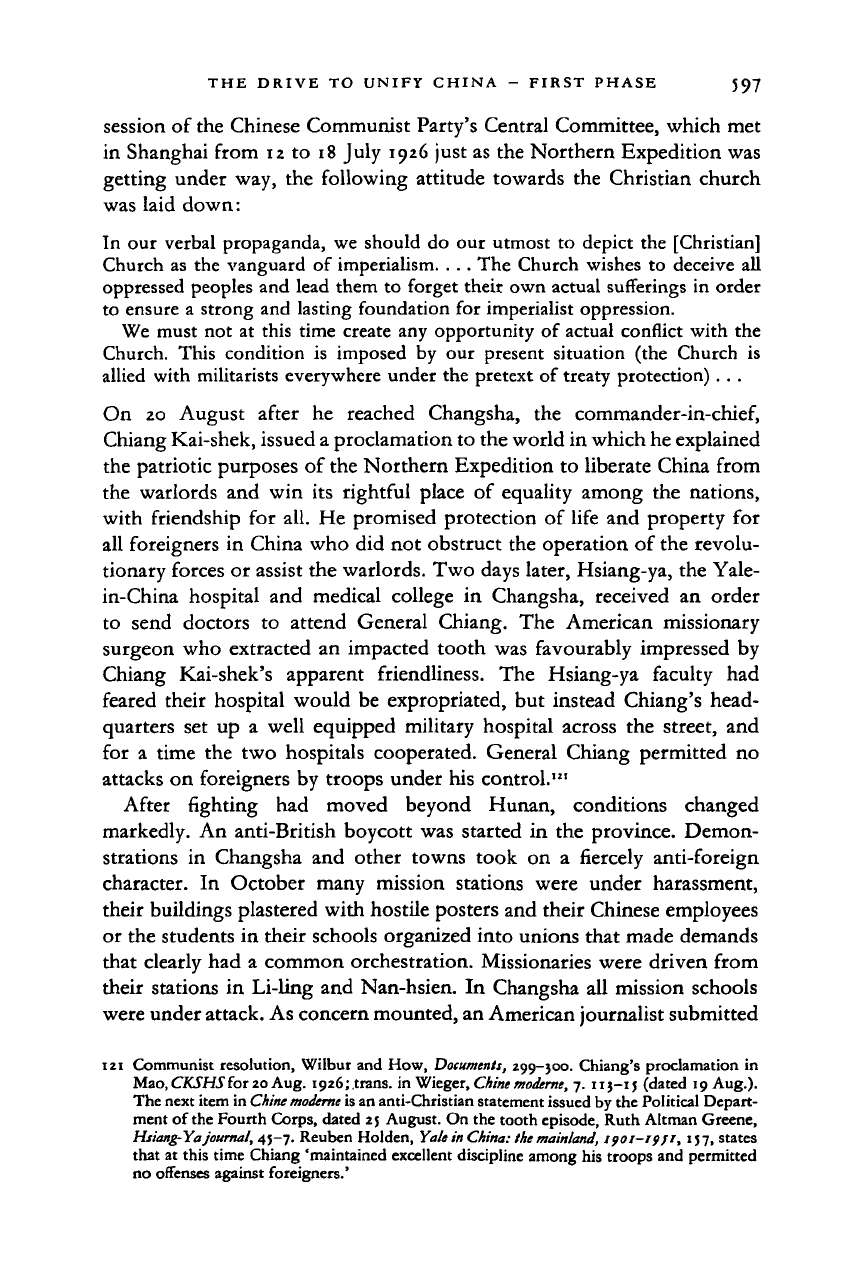
THE DRIVE TO UNIFY CHINA - FIRST PHASE 597
session of the Chinese Communist Party's Central Committee, which met
in Shanghai from 12 to 18 July 1926 just as the Northern Expedition was
getting under way, the following attitude towards the Christian church
was laid down:
In our verbal propaganda, we should do our utmost to depict the [Christian]
Church as the vanguard of imperialism. . . . The Church wishes to deceive all
oppressed peoples and lead them to forget their own actual sufferings in order
to ensure a strong and lasting foundation for imperialist oppression.
We must not at this time create any opportunity of actual conflict with the
Church. This condition is imposed by our present situation (the Church is
allied with militarists everywhere under the pretext of treaty protection). . .
On 20 August after he reached Changsha, the commander-in-chief,
Chiang Kai-shek, issued a proclamation to the world in which he explained
the patriotic purposes of the Northern Expedition to liberate China from
the warlords and win its rightful place of equality among the nations,
with friendship for all. He promised protection of life and property for
all foreigners in China who did not obstruct the operation of the revolu-
tionary forces or assist the warlords. Two days later, Hsiang-ya, the Yale-
in-China hospital and medical college in Changsha, received an order
to send doctors to attend General Chiang. The American missionary
surgeon who extracted an impacted tooth was favourably impressed by
Chiang Kai-shek's apparent friendliness. The Hsiang-ya faculty had
feared their hospital would be expropriated, but instead Chiang's head-
quarters set up a well equipped military hospital across the street, and
for a time the two hospitals cooperated. General Chiang permitted no
attacks on foreigners by troops under his control.
1
"
After righting had moved beyond Hunan, conditions changed
markedly. An anti-British boycott was started in the province. Demon-
strations in Changsha and other towns took on a fiercely anti-foreign
character. In October many mission stations were under harassment,
their buildings plastered with hostile posters and their Chinese employees
or the students in their schools organized into unions that made demands
that clearly had a common orchestration. Missionaries were driven from
their stations in Li-ling and Nan-hsien. In Changsha all mission schools
were under attack. As concern mounted, an American journalist submitted
121 Communist resolution, Wilbur and How,
Documents,
299-300. Chiang's proclamation in
Mao,CKSHSfor 20 Aug. 1926;.trans, in Wieger,
Chine
moderne,
7. 113-15 (dated 19 Aug.).
The next item in
Chine modtrne
is an anti-Christian statement issued by the Political Depart-
ment of the Fourth Corps, dated 25 August. On the tooth episode, Ruth Altman Greene,
Htiang-Ya journal, 45-7. Reuben Holden, Yale
in
China:
the
mainland,
1901-19)/, 157, states
that at this time Chiang 'maintained excellent discipline among his troops and permitted
no offenses against foreigners.'
Cambridge Histories Online © Cambridge University Press, 2008
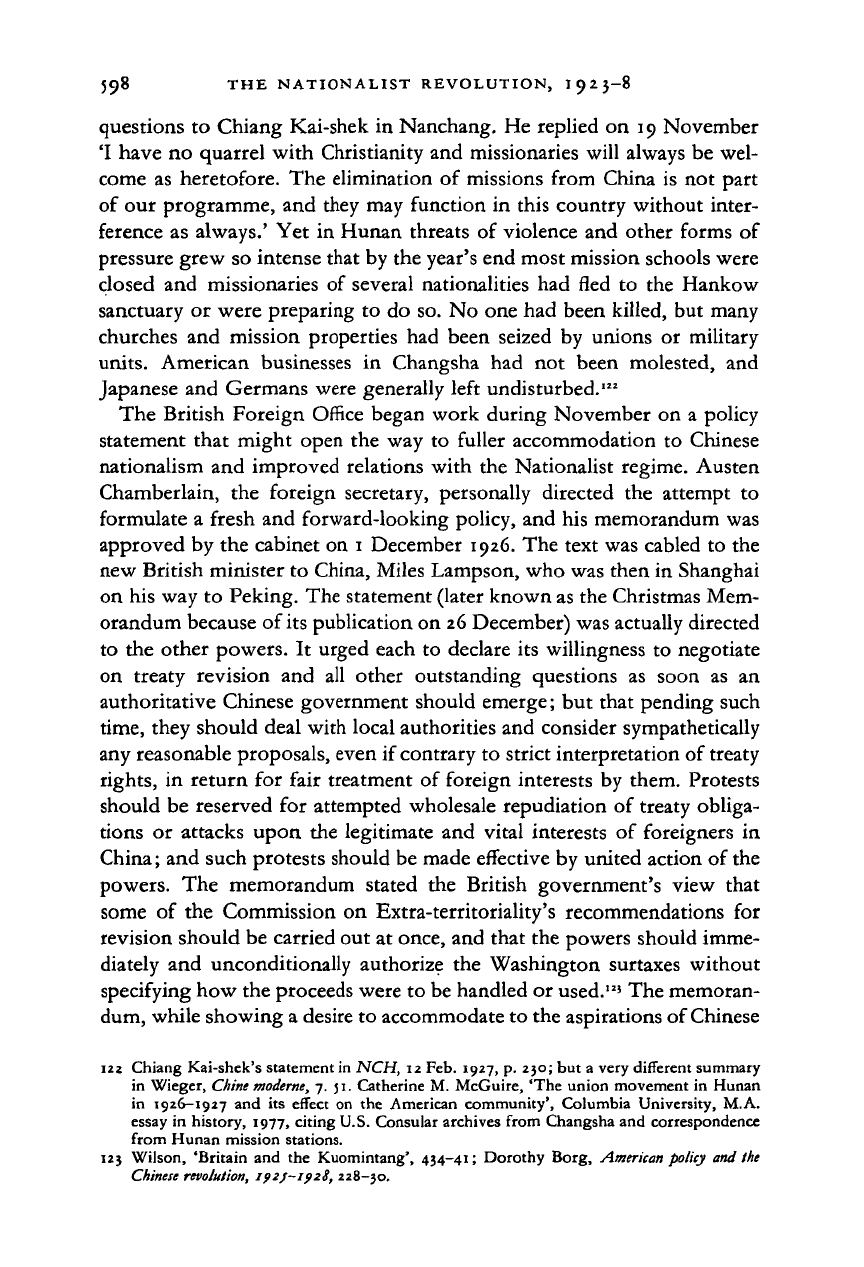
598 THE NATIONALIST REVOLUTION, 1925-8
questions
to
Chiang Kai-shek
in
Nanchang.
He
replied
on
19 November
'I have
no
quarrel with Christianity
and
missionaries will always
be
wel-
come
as
heretofore.
The
elimination
of
missions from China
is not
part
of our programme,
and
they may function
in
this country without inter-
ference
as
always.'
Yet in
Hunan threats
of
violence
and
other forms
of
pressure grew
so
intense that
by
the year's end most mission schools were
closed
and
missionaries
of
several nationalities
had
fled
to the
Hankow
sanctuary
or
were preparing
to do
so.
No
one had been killed,
but
many
churches
and
mission properties
had
been seized
by
unions
or
military
units.
American businesses
in
Changsha
had not
been molested,
and
Japanese
and
Germans were generally left undisturbed.
1
"
The British Foreign Office began work during November
on a
policy
statement that might open
the way to
fuller accommodation
to
Chinese
nationalism
and
improved relations with
the
Nationalist regime. Austen
Chamberlain,
the
foreign secretary, personally directed
the
attempt
to
formulate
a
fresh
and
forward-looking policy,
and his
memorandum was
approved
by the
cabinet
on
1
December 1926. The text was cabled
to the
new British minister
to
China, Miles Lampson, who was then
in
Shanghai
on his way
to
Peking. The statement (later known as the Christmas Mem-
orandum because of
its
publication on 26 December) was actually directed
to
the
other powers.
It
urged each
to
declare
its
willingness
to
negotiate
on treaty revision
and all
other outstanding questions
as
soon
as an
authoritative Chinese government should emerge;
but
that pending such
time,
they should deal with local authorities and consider sympathetically
any reasonable proposals, even
if
contrary
to
strict interpretation
of
treaty
rights,
in
return
for
fair treatment
of
foreign interests
by
them. Protests
should
be
reserved
for
attempted wholesale repudiation
of
treaty obliga-
tions
or
attacks upon
the
legitimate
and
vital interests
of
foreigners
in
China;
and
such protests should
be
made effective
by
united action
of
the
powers.
The
memorandum stated
the
British government's view that
some
of the
Commission
on
Extra-territoriality's recommendations
for
revision should
be
carried out
at
once, and that the powers should imme-
diately
and
unconditionally authorize
the
Washington surtaxes without
specifying how the proceeds were
to
be handled
or
used.
12
' The memoran-
dum, while showing a desire
to
accommodate
to
the aspirations of Chinese
I2z Chiang Kai-shek's statement in
NCH,
12 Feb. 1927, p. 230; but
a
very different summary
in Wieger,
Chine
moderne,
7.
51.
Catherine M. McGuire, 'The union movement
in
Hunan
in 1926-1927
and its
effect
on the
American community', Columbia University,
M.A.
essay
in
history, 1977, citing
U.S.
Consular archives from Changsha and correspondence
from Hunan mission stations.
123 Wilson, 'Britain
and the
Kuomintang',
434-41;
Dorothy Borg,
American policy and the
Chinese
revolution,
ipi/~if2S, 228—30.
Cambridge Histories Online © Cambridge University Press, 2008
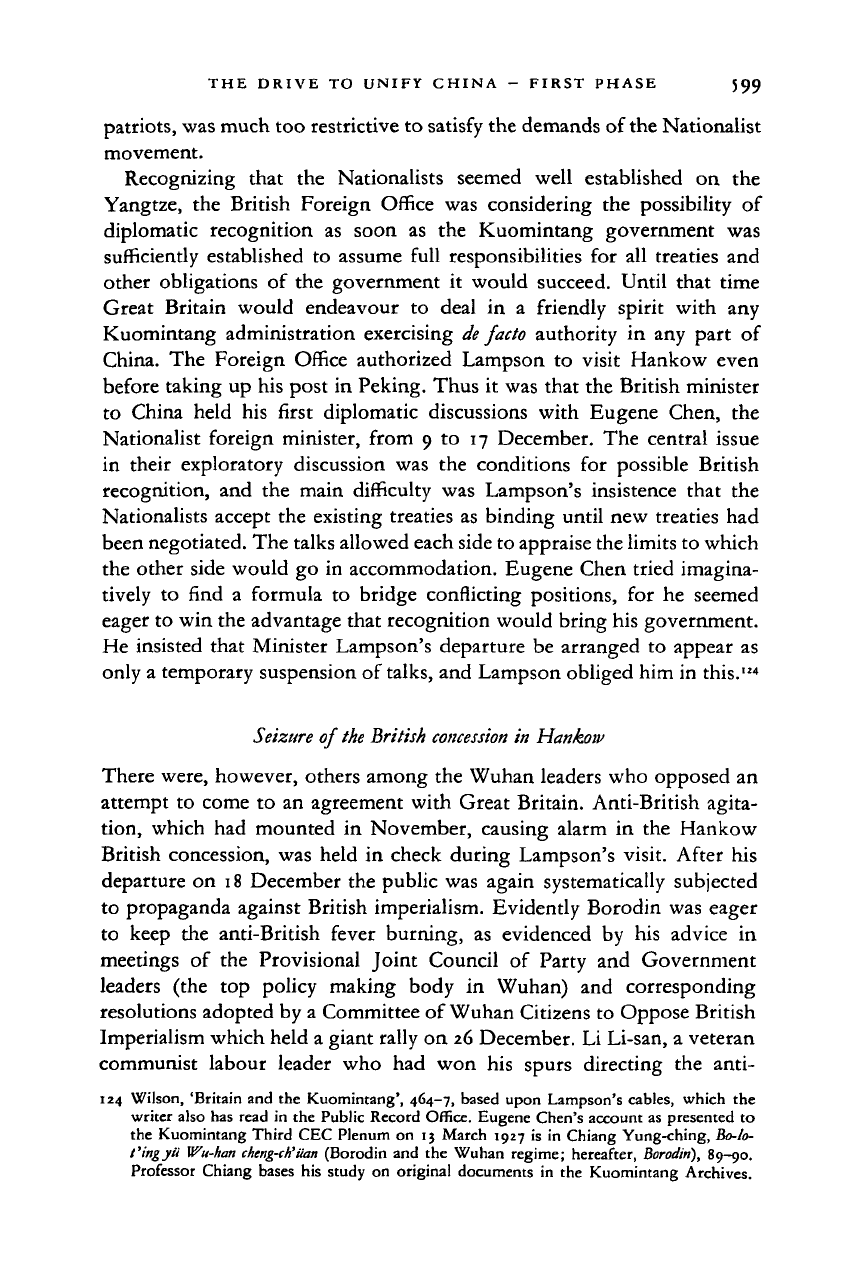
THE DRIVE TO UNIFY CHINA - FIRST PHASE 599
patriots, was much too restrictive
to
satisfy the demands of the Nationalist
movement.
Recognizing that
the
Nationalists seemed well established
on the
Yangtze,
the
British Foreign Office
was
considering
the
possibility
of
diplomatic recognition
as
soon
as the
Kuomintang government
was
sufficiently established
to
assume full responsibilities
for all
treaties
and
other obligations
of the
government
it
would succeed. Until that time
Great Britain would endeavour
to
deal
in a
friendly spirit with
any
Kuomintang administration exercising
de facto
authority
in any
part
of
China.
The
Foreign Office authorized Lampson
to
visit Hankow even
before taking
up his
post
in
Peking. Thus
it was
that
the
British minister
to China held
his
first diplomatic discussions with Eugene Chen,
the
Nationalist foreign minister, from
9 to 17
December.
The
central issue
in their exploratory discussion
was the
conditions
for
possible British
recognition,
and the
main difficulty
was
Lampson's insistence that
the
Nationalists accept
the
existing treaties
as
binding until
new
treaties
had
been negotiated. The talks allowed each side to appraise the limits
to
which
the other side would
go in
accommodation. Eugene Chen tried imagina-
tively
to
find
a
formula
to
bridge conflicting positions,
for he
seemed
eager
to
win the advantage that recognition would bring his government.
He insisted that Minister Lampson's departure
be
arranged
to
appear
as
only
a
temporary suspension
of
talks,
and
Lampson obliged
him in
this.
124
Seizure
of
the
British
concession
in
Hankow
There were, however, others among
the
Wuhan leaders
who
opposed
an
attempt
to
come
to an
agreement with Great Britain. Anti-British agita-
tion, which
had
mounted
in
November, causing alarm
in the
Hankow
British concession,
was
held
in
check during Lampson's visit. After
his
departure
on 18
December
the
public
was
again systematically subjected
to propaganda against British imperialism. Evidently Borodin
was
eager
to keep
the
anti-British fever burning,
as
evidenced
by his
advice
in
meetings
of the
Provisional Joint Council
of
Party
and
Government
leaders
(the top
policy making body
in
Wuhan)
and
corresponding
resolutions adopted
by a
Committee
of
Wuhan Citizens
to
Oppose British
Imperialism which held
a
giant rally
on
26 December.
Li
Li-san,
a
veteran
communist labour leader
who had won his
spurs directing
the
anti-
124 Wilson, 'Britain
and the
Kuomintang', 464-7, based upon Lampson's cables, which
the
writer also
has
read
in the
Public Record Office. Eugene Chen's account
as
presented
to
the Kuomintang Third CEC Plenum
on
13 March 1927
is in
Chiang Yung-ching,
Bo-lo-
t'ingyu
Wu-han chtng-ch'uan
(Borodin
and the
Wuhan regime; hereafter,
Borodin),
89-90.
Professor Chiang bases
his
study
on
original documents
in the
Kuomintang Archives.
Cambridge Histories Online © Cambridge University Press, 2008
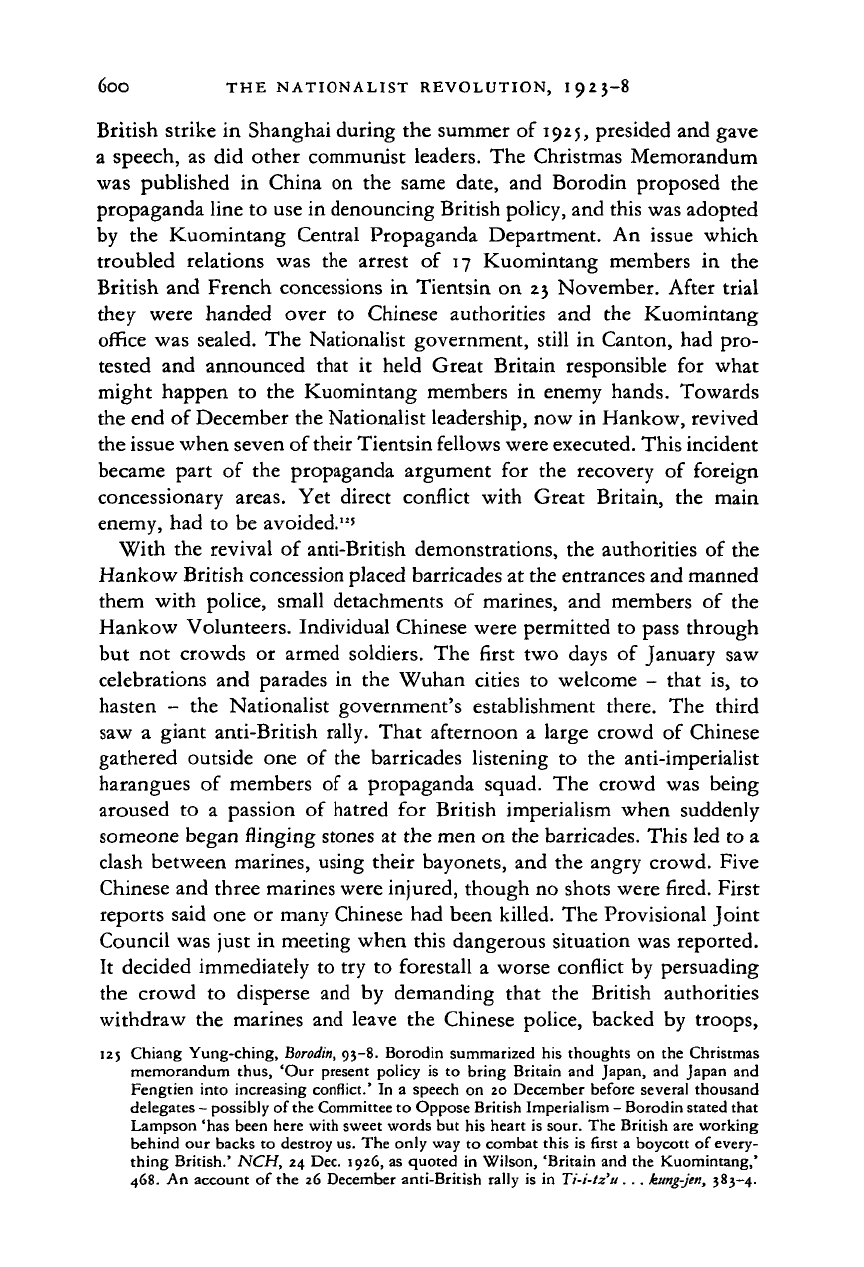
600 THE NATIONALIST REVOLUTION, I 923-8
British strike
in
Shanghai during
the
summer
of
1925, presided and gave
a speech,
as did
other communist leaders.
The
Christmas Memorandum
was published
in
China
on the
same date,
and
Borodin proposed
the
propaganda line
to
use
in
denouncing British policy, and this was adopted
by
the
Kuomintang Central Propaganda Department.
An
issue which
troubled relations
was the
arrest
of 17
Kuomintang members
in the
British
and
French concessions
in
Tientsin
on 23
November. After trial
they were handed over
to
Chinese authorities
and the
Kuomintang
office
was
sealed.
The
Nationalist government, still
in
Canton,
had pro-
tested
and
announced that
it
held Great Britain responsible
for
what
might happen
to the
Kuomintang members
in
enemy hands. Towards
the end
of
December the Nationalist leadership, now
in
Hankow, revived
the issue when seven
of
their Tientsin fellows were executed. This incident
became part
of the
propaganda argument
for the
recovery
of
foreign
concessionary areas.
Yet
direct conflict with Great Britain,
the
main
enemy,
had to be
avoided.
12
'
With
the
revival
of
anti-British demonstrations,
the
authorities
of the
Hankow British concession placed barricades
at
the entrances and manned
them with police, small detachments
of
marines,
and
members
of the
Hankow Volunteers. Individual Chinese were permitted
to
pass through
but
not
crowds
or
armed soldiers.
The
first
two
days
of
January
saw
celebrations
and
parades
in the
Wuhan cities
to
welcome
-
that
is, to
hasten
- the
Nationalist government's establishment there.
The
third
saw
a
giant anti-British rally. That afternoon
a
large crowd
of
Chinese
gathered outside
one of the
barricades listening
to the
anti-imperialist
harangues
of
members
of a
propaganda squad.
The
crowd
was
being
aroused
to a
passion
of
hatred
for
British imperialism when suddenly
someone began flinging stones
at
the men
on
the barricades. This led
to a
clash between marines, using their bayonets,
and the
angry crowd. Five
Chinese and three marines were injured, though
no
shots were fired. First
reports said
one or
many Chinese
had
been killed. The Provisional Joint
Council was just
in
meeting when this dangerous situation was reported.
It decided immediately
to try to
forestall
a
worse conflict
by
persuading
the crowd
to
disperse
and by
demanding that
the
British authorities
withdraw
the
marines
and
leave
the
Chinese police, backed
by
troops,
125 Chiang Yung-ching,
Borodin,
95-8. Borodin summarized
his
thoughts
on the
Christmas
memorandum thus,
'Our
present policy
is to
bring Britain
and
Japan,
and
Japan
and
Fengtien into increasing conflict.'
In a
speech
on 20
December before several thousand
delegates
-
possibly of the Committee
to
Oppose British Imperialism
-
Borodin stated that
Lampson 'has been here with sweet words
but
his heart
is
sour. The British are working
behind
our
backs
to
destroy us. The only way
to
combat this
is
first
a
boycott
of
every-
thing British.'
NCH,
24 Dec. 1926, as quoted
in
Wilson, 'Britain and
the
Kuomintang,'
468.
An
account
of
the
26
December anti-British rally
is in
Ti-i-tz'u.
. .
kung-jen,
383-4.
Cambridge Histories Online © Cambridge University Press, 2008
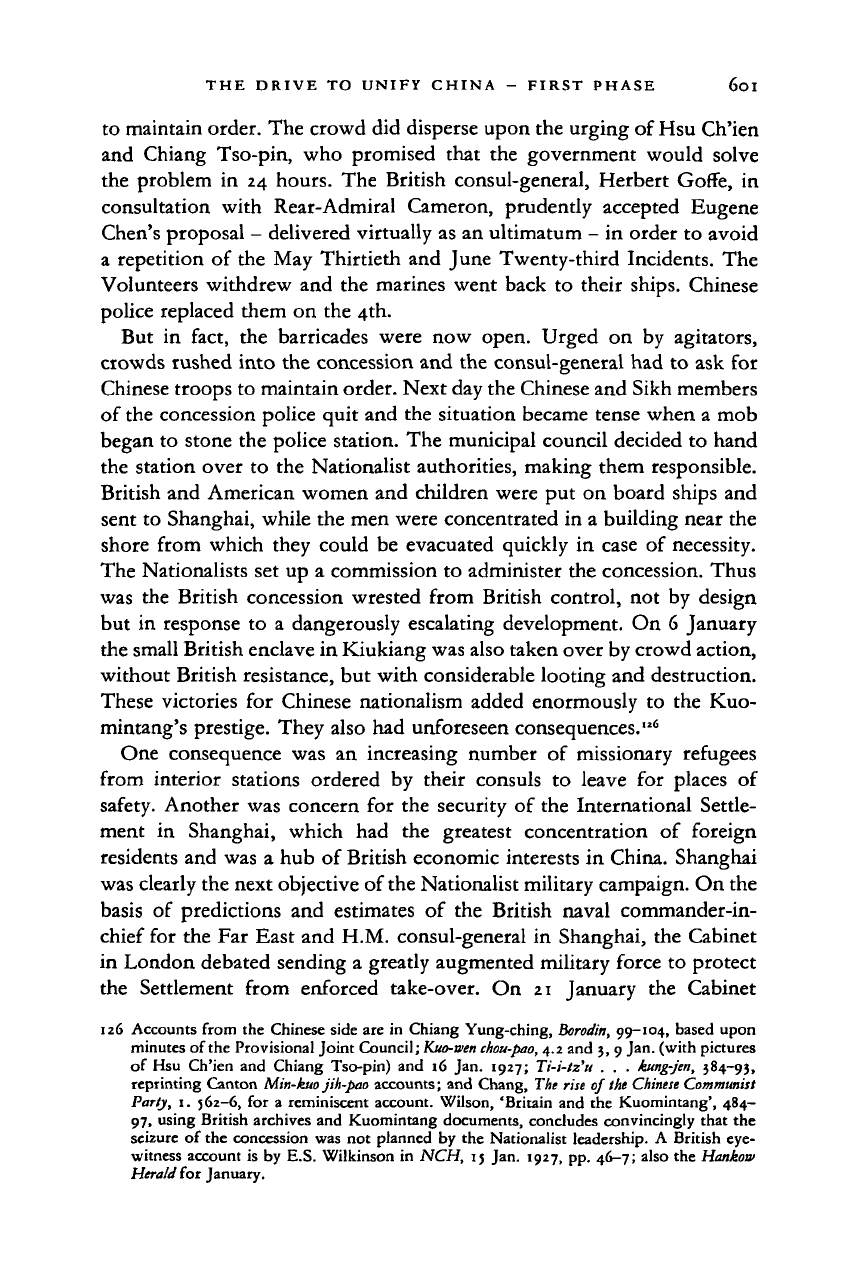
THE DRIVE TO UNIFY CHINA - FIRST PHASE 6oi
to maintain order. The crowd did disperse upon the urging of Hsu Ch'ien
and Chiang Tso-pin, who promised that
the
government would solve
the problem
in 24
hours.
The
British consul-general, Herbert Goffe,
in
consultation with Rear-Admiral Cameron, prudently accepted Eugene
Chen's proposal
-
delivered virtually as an ultimatum
- in
order to avoid
a repetition
of
the May Thirtieth and June Twenty-third Incidents.
The
Volunteers withdrew and
the
marines went back
to
their ships. Chinese
police replaced them
on
the 4th.
But
in
fact,
the
barricades were
now
open. Urged
on by
agitators,
crowds rushed into the concession and the consul-general had
to
ask
for
Chinese troops to maintain order. Next day the Chinese and Sikh members
of the concession police quit and the situation became tense when
a
mob
began to stone the police station. The municipal council decided
to
hand
the station over
to
the Nationalist authorities, making them responsible.
British and American women and children were put
on
board ships and
sent to Shanghai, while the men were concentrated in
a
building near the
shore from which they could
be
evacuated quickly
in
case
of
necessity.
The Nationalists set up
a
commission
to
administer the concession. Thus
was
the
British concession wrested from British control,
not by
design
but
in
response
to a
dangerously escalating development.
On 6
January
the small British enclave in Kiukiang was also taken over by crowd action,
without British resistance, but with considerable looting and destruction.
These victories
for
Chinese nationalism added enormously
to the
Kuo-
mintang's prestige. They also had unforeseen consequences."
6
One consequence
was an
increasing number
of
missionary refugees
from interior stations ordered
by
their consuls
to
leave
for
places
of
safety. Another was concern
for
the security
of
the International Settle-
ment
in
Shanghai, which
had the
greatest concentration
of
foreign
residents and was
a
hub
of
British economic interests
in
China. Shanghai
was clearly the next objective of the Nationalist military campaign. On the
basis
of
predictions
and
estimates
of the
British naval commander-in-
chief for the Far East and H.M. consul-general
in
Shanghai, the Cabinet
in London debated sending
a
greatly augmented military force
to
protect
the Settlement from enforced take-over.
On 21
January
the
Cabinet
126 Accounts from
the
Chinese side are
in
Chiang Yung-ching,
Borodin,
99-104, based upon
minutes of the Provisional Joint Council;
Kuo-wen
chou-pao,
4.2 and 3, 9 Jan. (with pictures
of Hsu Ch'ien and Chiang Tso-pin)
and 16
Jan. 1927; Ti-i-tz'u
. . .
kung-jen,
$84-93,
reprinting Canton Min-kuo jih-pao accounts; and Chang, The rise of the
Chinese Communist
Party,
1.
562-6,
for a
reminiscent account. Wilson, 'Britain and
the
Kuomintang', 484-
97,
using British archives and Kuomintang documents, concludes convincingly that
the
seizure
of
the concession was
not
planned
by
the Nationalist leadership.
A
British eye-
witness account
is by
E.S. Wilkinson
in NCH, 15
Jan. 1927, pp. 46-7; also the Hankow
Herald for January.
Cambridge Histories Online © Cambridge University Press, 2008
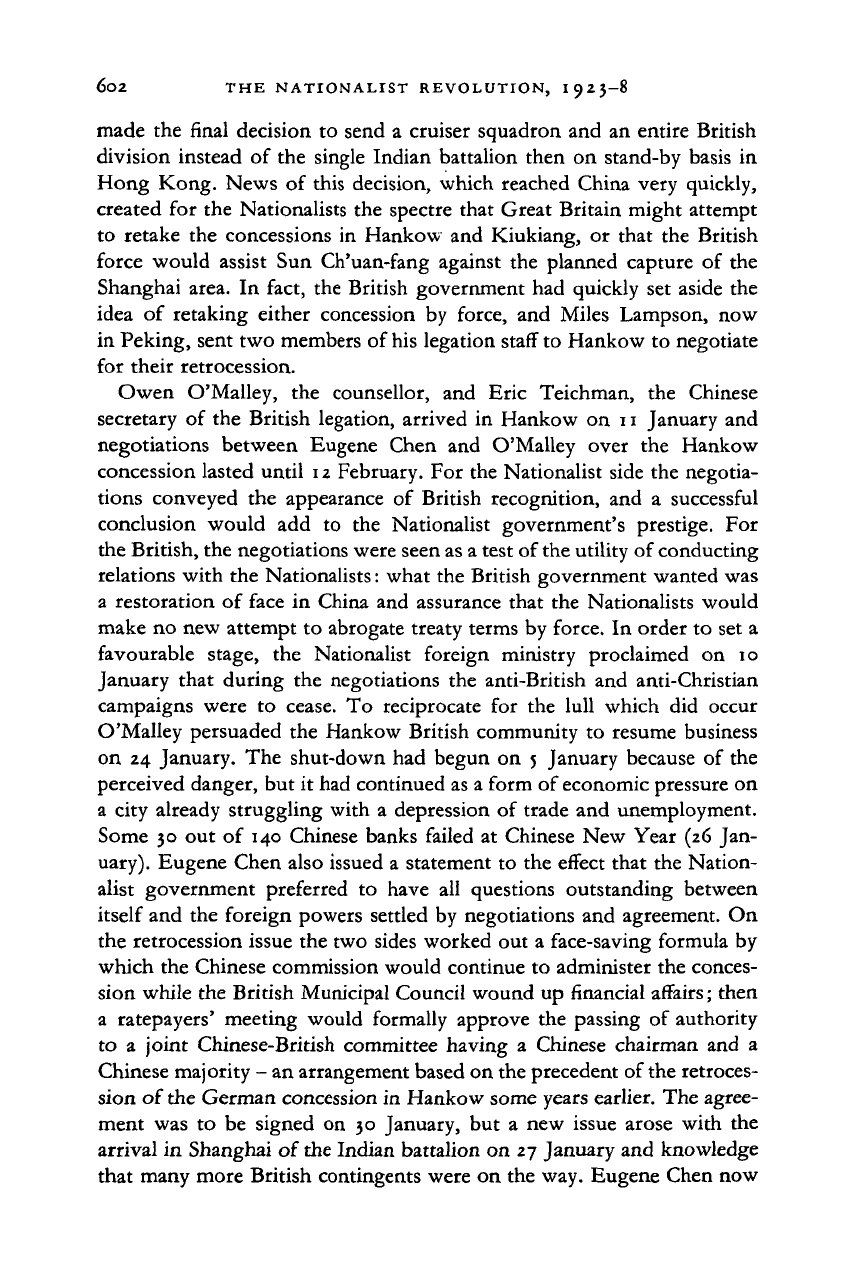
6o2 THE NATIONALIST REVOLUTION, I 923-8
made the final decision to send a cruiser squadron and an entire British
division instead of the single Indian battalion then on stand-by basis in
Hong Kong. News of this decision, which reached China very quickly,
created for the Nationalists the spectre that Great Britain might attempt
to retake the concessions in Hankow and Kiukiang, or that the British
force would assist Sun Ch'uan-fang against the planned capture of the
Shanghai area. In fact, the British government had quickly set aside the
idea of retaking either concession by force, and Miles Lampson, now
in Peking, sent two members of his legation staff to Hankow to negotiate
for their retrocession.
Owen O'Malley, the counsellor, and Eric Teichman, the Chinese
secretary of the British legation, arrived in Hankow on 11 January and
negotiations between Eugene Chen and O'Malley over the Hankow
concession lasted until
i 2
February. For the Nationalist side the negotia-
tions conveyed the appearance of British recognition, and a successful
conclusion would add to the Nationalist government's prestige. For
the British, the negotiations were seen as a test of the utility of conducting
relations with the Nationalists: what the British government wanted was
a restoration of face in China and assurance that the Nationalists would
make no new attempt to abrogate treaty terms by force. In order to set a
favourable stage, the Nationalist foreign ministry proclaimed on 10
January that during the negotiations the anti-British and anti-Christian
campaigns were to cease. To reciprocate for the lull which did occur
O'Malley persuaded the Hankow British community to resume business
on 24 January. The shut-down had begun on 5 January because of the
perceived danger, but it had continued as a form of economic pressure on
a city already struggling with a depression of trade and unemployment.
Some 30 out of 140 Chinese banks failed at Chinese New Year (26 Jan-
uary).
Eugene Chen also issued a statement to the effect that the Nation-
alist government preferred to have all questions outstanding between
itself and the foreign powers settled by negotiations and agreement. On
the retrocession issue the two sides worked out a face-saving formula by
which the Chinese commission would continue to administer the conces-
sion while the British Municipal Council wound up financial affairs; then
a ratepayers' meeting would formally approve the passing of authority
to a joint Chinese-British committee having a Chinese chairman and a
Chinese majority - an arrangement based on the precedent of the retroces-
sion of the German concession in Hankow some years earlier. The agree-
ment was to be signed on 30 January, but a new issue arose with the
arrival in Shanghai of the Indian battalion on 27 January and knowledge
that many more British contingents were on the way. Eugene Chen now
Cambridge Histories Online © Cambridge University Press, 2008
